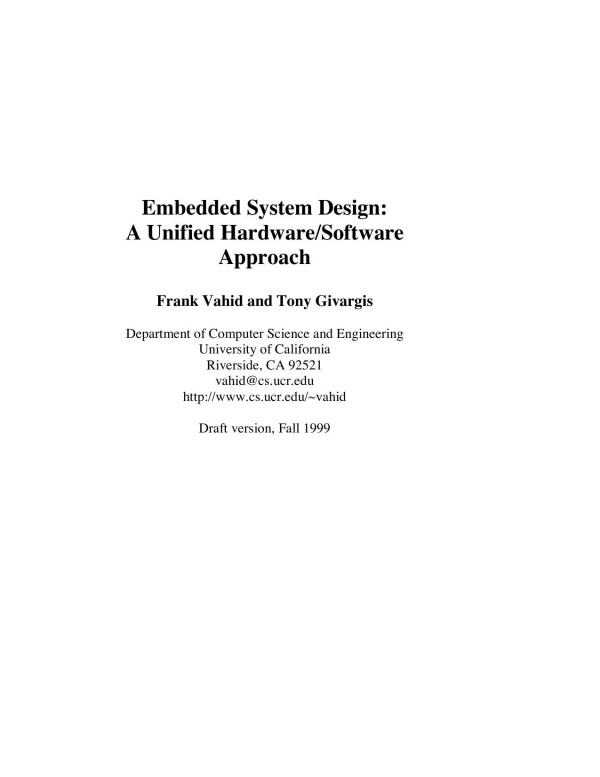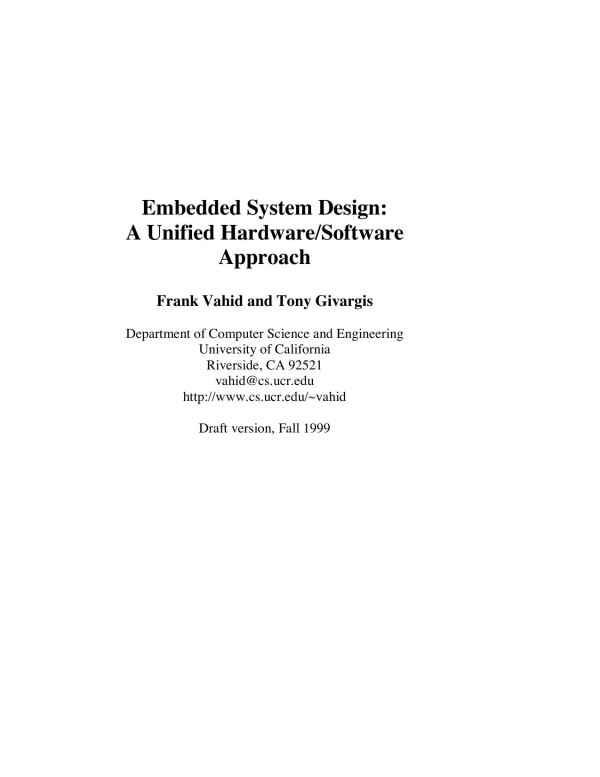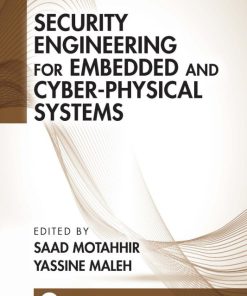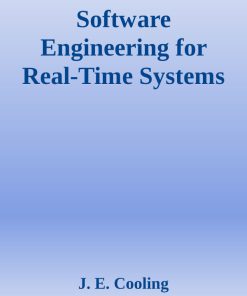Real Time Embedded Systems Design Principles and Engineering Practices 1st Edition by Xiaocong Fan 0128015071 9780128015070
$50.00 Original price was: $50.00.$25.00Current price is: $25.00.
Authors:Xiaocong Fan , Series:Artificial Intelligence [29] , Tags:Computers; Hardware; Chips & Processors , Author sort:Fan, Xiaocong , Ids:Google; 9780128015070 , Languages:Languages:eng , Published:Published:Feb 2015 , Publisher:Elsevier Science , Comments:Comments:This book integrates new ideas and topics from real time systems, embedded systems, and software engineering to give a complete picture of the whole process of developing software for real-time embedded applications. You will not only gain a thorough understanding of concepts related to microprocessors, interrupts, and system boot process, appreciating the importance of real-time modeling and scheduling, but you will also learn software engineering practices such as model documentation, model analysis, design patterns, and standard conformance. This book is split into four parts to help you learn the key concept of embedded systems; Part one introduces the development process, and includes two chapters on microprocessors and interrupts—fundamental topics for software engineers; Part two is dedicated to modeling techniques for real-time systems; Part three looks at the design of software architectures and Part four covers software implementations, with a focus on POSIX-compliant operating systems. With this book you will learn: The pros and cons of different architectures for embedded systems POSIX real-time extensions, and how to develop POSIX-compliant real time applications How to use real-time UML to document system designs with timing constraints The challenges and concepts related to cross-development Multitasking design and inter-task communication techniques (shared memory objects, message queues, pipes, signals) How to use kernel objects (e.g. Semaphores, Mutex, Condition variables) to address resource sharing issues in RTOS applications The philosophy underpinning the notion of “resource manager” and how to implement a virtual file system using a resource manager The key principles of real-time scheduling and several key algorithms Coverage of the latest UML standard (UML 2.4) Over 20 design patterns which represent the best practices for reuse in a wide range of real-time embedded systems Example codes which have been tested in QNX—a real-time operating system widely adopted in industry
Real Time Embedded Systems Design Principles and Engineering Practices 1st Edition by Xiaocong Fan – Ebook PDF Instant Download/Delivery. 0128015071, 9780128015070
Full download Real Time Embedded Systems Design Principles and Engineering Practices 1st Edition after payment

Product details:
ISBN 10: 0128015071
ISBN 13: 9780128015070
Author: Xiaocong Fan
This book integrates new ideas and topics from real time systems, embedded systems, and software engineering to give a complete picture of the whole process of developing software for real-time embedded applications. You will not only gain a thorough understanding of concepts related to microprocessors, interrupts, and system boot process, appreciating the importance of real-time modeling and scheduling, but you will also learn software engineering practices such as model documentation, model analysis, design patterns, and standard conformance.
This book is split into four parts to help you learn the key concept of embedded systems; Part one introduces the development process, and includes two chapters on microprocessors and interrupts—fundamental topics for software engineers; Part two is dedicated to modeling techniques for real-time systems; Part three looks at the design of software architectures and Part four covers software implementations, with a focus on POSIX-compliant operating systems.
With this book you will learn:
- The pros and cons of different architectures for embedded systems
- POSIX real-time extensions, and how to develop POSIX-compliant real time applications
- How to use real-time UML to document system designs with timing constraints
- The challenges and concepts related to cross-development
- Multitasking design and inter-task communication techniques (shared memory objects, message queues, pipes, signals)
- How to use kernel objects (e.g. Semaphores, Mutex, Condition variables) to address resource sharing issues in RTOS applications
- The philosophy underpinning the notion of “resource manager” and how to implement a virtual file system using a resource manager
- The key principles of real-time scheduling and several key algorithms
- Coverage of the latest UML standard (UML 2.4)
- Over 20 design patterns which represent the best practices for reuse in a wide range of real-time embedded systems
- Example codes which have been tested in QNX—a real-time operating system widely adopted in industry
Real Time Embedded Systems Design Principles and Engineering Practices 1st Table of contents:
Part I: Introduction
Chapter 1: Introduction to Embedded and Real-Time Systems
Abstract
1.1 Embedded Systems
1.2 Real-Time Systems
1.3 Case Study: Radar System
Problems
Chapter 2: Cross-Platform Development
Abstract
2.1 Cross-Platform Development Process
2.2 Hardware Architecture
2.3 Software Development
2.4 Build Target Images
2.5 Transfer Executable File Object to Target
2.6 Integrated Testing on Target
2.7 System Production
Problems
Chapter 3: Microprocessor Primer
Abstract
3.1 Introduction to Microprocessors
3.2 Microchip PIC18F8720
3.3 Intel 8086
3.4 Intel Pentium
3.5 ARM926EJ-S
Problems
Chapter 4: Interrupts
Abstract
4.1 Introduction to Interrupts
4.2 External Interrupts
4.3 Software Interrupts
4.4 Internal Interrupts
4.5 Design Patterns for ISRs
4.6 Interrupt Response Time
4.7 Case Study: x86
4.8 Case Study: ARM Processor
Problems
Chapter 5: Embedded System Boot Process
Abstract
5.1 System Bootloader
5.2 System Boot Process
5.3 Case Study: AT91SAM9G45 Boot Process
5.4 Load ELF Objects Embedded Within an OS Image
5.5 Case Study: Boot Process of QNX-based Embedded Systems
Problems
Part II: Real-Time System Modeling
Chapter 6: Fundamental UML Structural Modeling
Abstract
6.1 Unified Modeling Language
6.2 Class Diagram and Class Modeling
6.3 Class Modeling Principles
6.4 Object Diagram
6.5 Package Diagram
Problems
Chapter 7: Architecture Modeling in UML
Abstract
7.1 Levels of Architectural Abstraction
7.2 UML Structure Diagram
7.3 Modeling Components
7.4 Modeling Subsystems
7.5 Modeling a Complete System
7.6 Deployment Diagram
Problems
Chapter 8: Fundamental UML Behavioral Modeling
Abstract
8.1 Use Case Diagram and Use Case Modeling
8.2 Sequence Diagram
8.3 Activity Diagram
Problems
Chapter 9: Modeling Stateful Behaviors in UML
Abstract
9.1 Basics of a State Machine Diagram
9.2 Composite States
9.3 Inheritance of State Behavior
9.4 Stateful Object Timing Diagrams
9.5 Example: Modeling Stateful Behavior of a Radar System
Problems
Chapter 10: Real-Time UML: General Resource Modeling
Abstract
10.1 Real-Time UML Profile
10.2 Resource Modeling
10.3 Time Modeling
10.4 Concurrency Modeling
Problems
Chapter 11: Real-Time UML: Model Analysis
Abstract
11.1 Elicitation of Timing Constraints
11.2 RT-UML Profile Schedulability Modeling Subprofile
11.3 RT-UML Profile Performance Modeling Subprofile
Problems
Part III: Real-Time System Design
Chapter 12: Software Architectures for Real-Time Embedded Systems
Abstract
12.1 Real-Time Tasks
12.2 Round-Robin Architecture
12.3 Round Robin with Interrupts
12.4 Queue-Based Architecture
Problems
Chapter 13: POSIX and RTOS
Abstract
13.1 Introduction to POSIX
13.2 Task Statics and Dynamics
13.3 Real-Time OSs
13.4 POSIX Real-Time Scheduling Policies
13.5 Other Real-Time Scheduling Policies
Problems
Chapter 14: Multitasking
Abstract
14.1 Introduction to Multitasking
14.2 Multitask Design
14.3 Multitask Resource Sharing
14.4 Addressing Resource Deadlocks
14.5 Addressing Priority Inversion
Problems
Chapter 15: Real-Time Scheduling: Clock-Driven Approach
Abstract
15.1 Introduction to Cyclic Scheduling
15.2 Ad-hoc Clock-Driven Scheduling
15.3 Frame-Based Scheduling
15.4 Scheduling Aperiodic Jobs
15.5 Task Splitting
Problems
Chapter 16: Real-Time Scheduling: Rate-Monotonic Approach
Abstract
16.1 Priority Assignment
16.2 RMA Principle
16.3 Rate-Monotonic Analysis
16.4 Completion-Time Test
16.5 Period Transformation
16.6 Generalized Schedulability Analysis
Problems
Chapter 17: Real-Time Scheduling: Sporadic Server
Abstract
17.1 Sporadic Tasks
17.2 Sporadic Server
17.3 A Naive Sporadic Server
17.4 A Fixed-Priority Sporadic Server
17.5 A Dynamic-Priority Sporadic Server
Problems
Part IV: Implementation Patterns
Chapter 18: Resource Sharing
Abstract
18.1 Shared Variables
18.2 Shared Memory
18.3 Semaphore
18.4 Mutex
18.5 Condition Variable
Problems
Chapter 19: Intertask Communication: Message Queue
Abstract
19.1 Introduction to Message Queues
19.2 Message Queue Statics and Dynamics
19.3 Message Queue Usage Patterns
19.4 POSIX Functions for Message Queues
19.5 An Example of Using Message Queues
Problems
Chapter 20: Intertask Communication: Pipe
Abstract
20.1 Introduction to Pipes
20.2 Pipe Statics and Dynamics
20.3 Pipe Usage Patterns
20.4 POSIX Functions for Pipes
20.5 An Example of Using Pipes
Problems
Chapter 21: Intertask Communication: Signaling
Abstract
21.1 Introduction to POSIX Signals
21.2 Signal Handling
21.3 Signal Vector Table and Handlers
21.4 POSIX Signal Functions
21.5 QNX Implementation of POSIX Signals
21.6 Spinlocks and Interrupt Events from ISRs
21.7 QNX Pulses
Problems
Chapter 22: Software Timer Management
Abstract
22.1 Hardware Timer and Software Timer
22.2 Software Timer Manager
22.3 Timing Wheels
22.4 Hierarchical Timing Wheels
Problems
Chapter 23: QNX Resource Management
Abstract
23.1 Introduction to QNX Resource Management
23.2 Resource Manager Architecture
23.3 Example 1: Calculator as a Resource Manager
23.4 Example 2: Device Drivers
People also search for Real Time Embedded Systems Design Principles and Engineering Practices 1st:
real time systems design principles for distributed embedded applications
real time software design for embedded systems
real time software design for embedded systems pdf
real time systems design principles for distributed embedded applications pdf
You may also like…
eBook PDF
Software Engineering for Real Time Systems 1st Edition by Jim Cooling ISBN 0201596202 9780201596205
eBook PDF
Digital Design Principles and Practices 4th edition by John Wakerly ISBN 0131733494 978-0131733497












